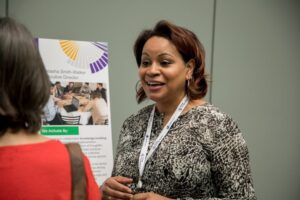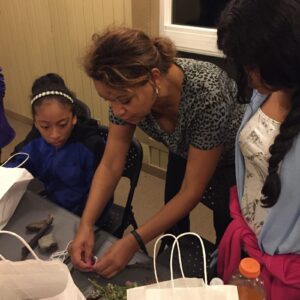Natasha Smith-Walker is the Executive Director, Project Exploration, in the Chicago STEM Pathways Cooperative.
In addition to the standard profiles of STEM leaders, this month we also asked for a summary of thoughts on the Spring 2018 national STEM Learning Ecosystems convening. Natasha’s insights and profile follow.
 At the Community of Practice Convening, one session, The Power of Partnerships: An Inside Look at Communities that are Making a Difference, provided a well-rounded look at the value of the STEM Learning Ecosystems framework. As cities work toward addressing effective STEM education, skill development and workforce gaps, the evolution of public-private-corporate collaborations are necessary to build effective bridges between students, parents, educators, and employers.
At the Community of Practice Convening, one session, The Power of Partnerships: An Inside Look at Communities that are Making a Difference, provided a well-rounded look at the value of the STEM Learning Ecosystems framework. As cities work toward addressing effective STEM education, skill development and workforce gaps, the evolution of public-private-corporate collaborations are necessary to build effective bridges between students, parents, educators, and employers.
Several key takeaways continues to surface and resonate for Chicago’s approach. First, high quality STEM learning opportunities go beyond traditional classroom settings. It is necessary to engage stakeholders outside of “regular settings” to structure learning opportunities for children who have been traditionally underrepresented in STEM. Second, fostering relationships with schools and teachers to expand learning opportunities can support learning for both educators and students. Finally, involving employers and the corporate sector is vital. Business sector STEM partnerships are instrumental in creating meaningful connections and authentic experience between curriculum and practical application.
Children become much more engaged in STEM because they begin to make personal connections. Ecosystems can work on bringing together formal and informal STEM learning opportunities for students to develop and engage with STEM skills and knowledge to develop and increase their readiness for college, careers, and life.
For example, “One Summer Chicago 2018” is a partnership between the Department of Family and Support Services, Chicago Public Schools, Apple, City Colleges, and Chicago Learning Exchange to create pathways in technology for Chicago youth. There are several aspects:
Develop Interest: Coding clubs will be held at schools and/or community-based organizations to spark interest in technology.
Get trained: Apple will host a summer skill development program with 20 high school students.
Get connected: Pre-professional internship with an employer mentoring a small group of aspiring coders through project-based activities.
Get Started: Professional internship guides an aspiring coder through activities they would experience as a professional.
This example of partnerships between several regional partners perfectly illustrates the work of the Chicago STEM Pathways Cooperative and all of the STEM Learning Ecosystems. Now, learn a little more about Natasha herself.
1. What’s your background?
I have been working in the youth development and education field for over 20 years. I started as a classroom teacher and began to explore the out of school time when I started working at the James Jordan Boys and Girls Club on the west side of Chicago. I held several positions that helped me learn and understand community development, organizing, and program development with an interest in children, youth and families. I started my college career as an architecture major, but similar to the same issues that currently exist around minorities and women persisting in STEM field in college, I experienced limited supports. I eventually earned my degree in political science.
2. Describe your role in your local STEM Ecosystem.
Founded in 1999, PE uses STEM education to address challenges to equity, access, and opportunity in public education, higher education, and the professional STEM world. In 2011 PE began to explore the STEM landscape in Chicago and administered a survey. Taking this data we convened a meeting with over 100 stakeholders to respond to the data and produced a report which listed several recommendations. It was this work that led us to learning about the movement around building STEM Learning ecosystems. Because of our work around convening we are now serving as the backbone to the Chicago STEM Pathways Cooperative which leads Chicago STEM learning ecosystem work.
3. What are you working on for the future for the Ecosystem?

Currently we are working on developing a STEM learning center on the westside of Chicago. The Austin STEM Learning Center (SLC), will be housed at the George Leland Chicago Public School Annex, and serve as a regional site to anchor high-quality STEM learning opportunities for youth in the West Side communities. Ultimately, the SLC aims to be a STEM learning hub for youth, families, and teachers; it will draw CPS classrooms from across the city for high-quality experiential learning, amplify the value of STEM learning in the community, bridge citywide STEM resources with local assets, and strengthen collaboration among regional and citywide stakeholders.
4. What do think can be accomplished within the framework of the Ecosystems that can’t be done (or is more difficult) without it?
Key to the ecosystem framework is momentum and credibility around the value and impact of pulling in cross-sector partners to address inequities in STEM education. Developing a model where stakeholders plug in to support existing work but most importantly coming together to identify where gaps lie has been beneficial.
5. What’s the most fun and/or rewarding part of your job?
I love the ability to expose students to opportunities that they normally would never have. We recently sent 15 high school students from a low income school to Argonne National Laboratories to work with a scientist that was testing an x-ray for insects. As much as the students were freaked out they looked at Brownbanded Cockroach with complete interest!
Congratulations to Natasha on her selection as a Fellow in the LEAD STEM program.

